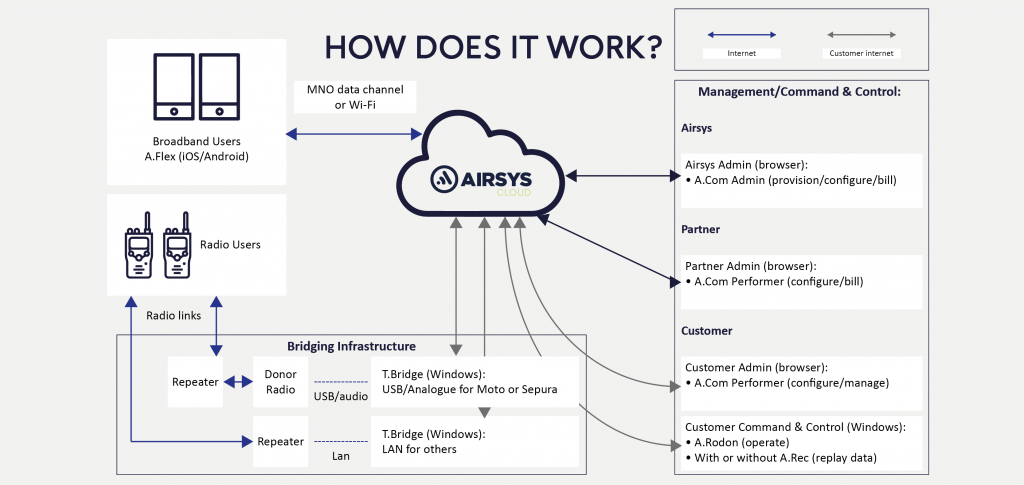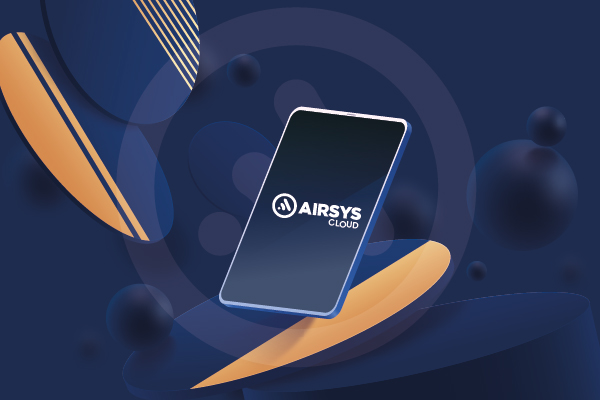Introduction
Bridging allows Airsys.Cloud Customers to turn an existing LMR channel into a client for their Airsys.Cloud BBPTT service so that LMR and BBPTT users can communicate.
In addition, bridging opens up the possibility of using a single Command and Control entity (A.Rodon Dispatch) to locate, manage and communicate with the combined LMR/BBPTT fleet.
Multiple bridges, LMR systems & dispatchers are supported.

What’s involved?
Talk to the team at Airsys.Cloud about your existing LMR system and how we can extend its reach and functionality with Airsys.Cloud.
Fundamentally we deal with different radio systems in one of three ways:
- Where LMR suppliers have published their repeater API specifications and we have bridge software, we can connect a repeater directly to a bridge with a standard ethernet cable. This connection will carry both audio and data.
- Where repeater API specifications are unavailable or where a donor radio is the preferred approach and we have bridge software, we can connect the donor radio to a bridge using a cable designed specifically for that donor radio. A bespoke cable is required to match impedance and levels and accommodate different data standards. Two USB ports are required per channel on each bridge.
- Where 1 & 2 above are not appropriate e.g. where the donor radio has no compatible data connection, we can deploy a 4-wire analogue bridge. Again, a bespoke cable may be required to match impedance and levels. In this scenario the donor radio will need a Voice Operated Switch capability as it will need to detect audio out of a bridge for transmission by the donor and activate PTT automatically. One USB port is required per channel on each bridge.
Bridge clients run on a Windows PC/Laptop. Multiple bridge clients can be run on the same machine providing sufficient network/USB connectivity is available. USB concentrators have been used successfully.
Provided your LMR system has the necessary repeater APIs enabled or compatible donor radio(s) in place, you will need to procure one or more bespoke cables and bridge machines. Bridge clients themselves attract a simple monthly subscription (per channel) irrespective of the number of LMR users in play.

What functionality do I get?
You will not be surprised to learn that the functionality available from LMR/BBPTT bridging typically depends on the LMR system and the method of bridging.
Depending on the LMR system and the capability of the LMR devices involved:
- 3 above will provide group calling…
- 2 above should add one-to-one calling, group & one-to-one messaging and location (where available. LMR user locations will be available to BBPTT users including the dispatcher).
- 1 above will do the same as 2 above but with more certainty.
That being said, the bulk of our bridging deployments use method 2 but only really focus on group calling as adding all the BBPTT contacts to the radios to support one-to-one calling of BBPTT contacts from radios is often a step customers don’t take.
Each bridge client in play creates a channel in the BBPTT system. LMR users can move from one bridge channel to another (by changing channel on their LMR system) and BBPTT users can join the bridge channels thereby providing the means for LMR and BBPTT users to communicate with each other.
If your BBPTT system is set up with some channels that are not bridge channels (most of our BBPTT systems are set up in this way), these non-bridge channels cannot be joined by LMR users.
If you commission e.g. a Motorola Solutions bridge channel and a Kenwood bridge channel, the users of the Motorola Solutions and Kenwood LMR systems will be on those (separate) channels and will be unable to talk to each other unless we deploy some cross connect capabilities at our disposal. This is something you will need to talk to the team at Airsys.Cloud about.

Summary:
Bridging provides the solution to help overcome the challenges of integrating LMR systems with BBPTT devices. It is easy-to-use and easy to-scale.
Furthermore, bridge channels are available to Airsys.Cloud’s Command and Control Centre Solution, allowing command and control centre staff to locate, manage and communicate with both LMR and BBPTT users from a single terminal.
The team at Airsys.Cloud
Contact Us
Our dedicated team of Broadband Push-to-Talk specialists are here to work with you to deliver your needs, whatever your requirements.
Within the Broadband Push-to-Talk market, Airsys.Cloud has become an essential provider of telecommunications solutions. Discuss with our team today on how we can do more with what you have.

